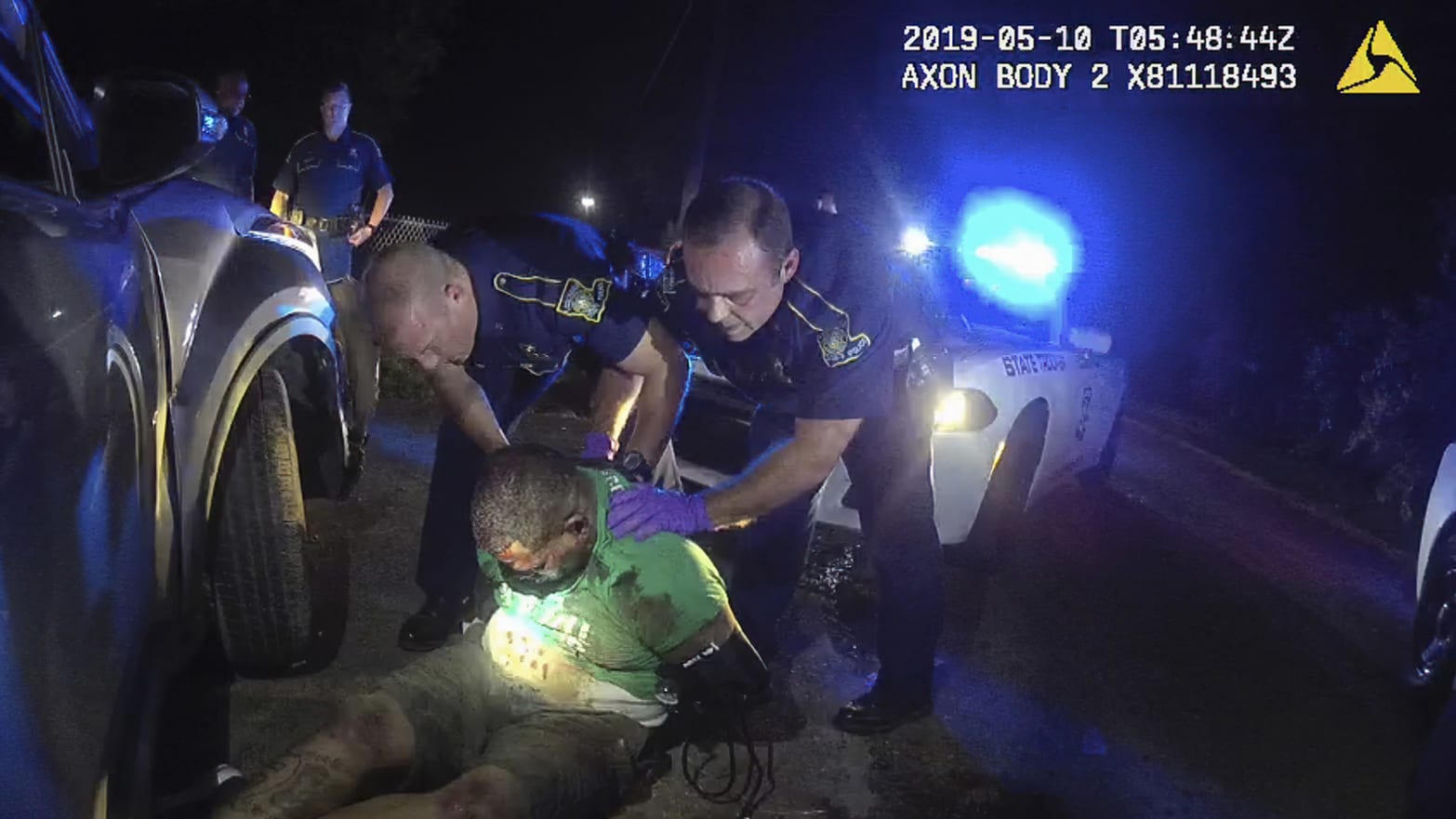More snippets of body-camera footage from the brutal 2019 arrest of Ronald Greene in Louisiana emerged on Friday, showing the unarmed man facedown on the ground with arms and feet shackled while an officer yells at him not to turn over.
“Lay on your belly! Lay on your belly!”Louisiana State Police Trooper Kory York shouted at Greene, who repeatedly tried to turn over. “You better lay on your fucking belly like I told you to!”
Seemingly terrified, Greene says, “Yes, sir.” At other points in the video the Black 49-year-old barber can be heard moaning in pain and is seen face down in a pool of his own blood.
An autopsy report cites the way the heavyset Greene was restrained as one of the factors in his death, the AP reported.
Louisiana State Police say Greene died on his way to the hospital—though their initial report squarely blamed his death on a crash following a high-speed chase and omitted the violence that is clear on the bodycam footage.
The videos that came out Friday are a second batch to be released after the AP and also reveal how troopers spoke about the arrest and beating with each other.
One of the clips shared on Twitter by civil rights attorney S. Lee Merritt, who is representing the Greene family, shows Louisiana State Police Lt. John Cleary arriving at the scene.
He asks an officer if he is OK to which he responds, “Yes sir, just cleaning blood off.” As he gets closer to where Greene is lying on the ground and screaming in pain, he asks another officer if he is okay. “Yeah, I got blood all over me,” that trooper says.
Later Cleary says “everybody did good.”
Another clip caught Trooper Chris Hollingsworth talking about the confrontation.
“I beat the ever-living fuck out of him, choked him and everything else trying to get him under control,” he says. “All of a sudden he just went limp... I thought he was dead.”
The other officer asks, “You all got that on bodycam?” and moments later, Hollingsworth shuts off his camera.
The new snippets of video come from a 30-minute clip recently released to Greene’s family—two years after a traffic stop in Monroe ended with his death, which has now sparked a federal investigation.
The Louisiana State Police did not respond to a request for comment from The Daily Beast.
In a statement to the AP earlier this week they said the public release of video snippets was “premature” and “undermines the investigative process and compromises the fair and impartial outcome.”
But Chad Marlow, senior policy counsel at the ACLU, said the long delay in releasing the video undermines the promise of transparency that body cameras were supposed to usher in when they began to be widely used by law enforcement agencies.
Marlow said that while some law enforcement agencies release footage in a timely manner, it is far from the norm—thanks to layers of rules that differ widely between states and individual departments. Depending on the state, he said, the decision can rest in the hands of a law enforcement agency, be left up to laws passed by the state legislature, or fall to the courts.
“Your experience of body cameras and whether they are a benefit or not should not vary from jurisdiction to jurisdiction,” he said.
In October 2020, the ACLU released a model bodycam policy it hoped would be adopted by states to create uniformity around when they should be used and when footage should be available for public view. Some states have already used the model to create their own protocols.
That includes Ohio, where body-camera video of a Columbus Police Department officer shooting and killing 16-year-old Ma’Khia Bryant in April was released swiftly because it’s considered a public record.
In North Carolina, on the other hand, body-camera footage is not considered public record and can only be seen by petitioning a court for its release—a process that played out after the April shooting of Andrew Brown Jr. in Elizabeth City.
Louisiana state’s public records statute says records related to “pending criminal litigation” or “any criminal litigation” that can be “reasonably anticipated” are not considered public records. The statute also exempts body camera footage from being shared without a court order if sharing it would “violate an individual's reasonable expectation of privacy.”
The model policy advocated by the ACLU calls for anyone caught on body camera, their family, or their attorneys to be able to view the footage at any point. It also calls for the ability for the public to request footage and have it be released in accordance with state open records laws.
The ACLU also recommends that bodycam footage should not be withheld from the public or anyone else on the basis of an “active investigation” if the person whose conduct is being called into question is a law enforcement officer.
Marlow said without such a policy, departments often have a loophole to get out of releasing footage they would otherwise have to release by claiming it is part of an ongoing investigation.
He said that policy makes sense if there is a criminal suspect police don’t want to tip off, but not if an officer is the one under suspicion. “They’re the one who committed the act, so they’re not being tipped off to anything,” he said. “They’ve probably already seen the footage.”
The flip side of this is that law enforcement agencies typically have broad discretion to release videos that make officers look good. The result, Marlow said, is that bodycam video can be manipulated into a “police propaganda tool.”
“That is certainly not what they were intended to be,” he said.

